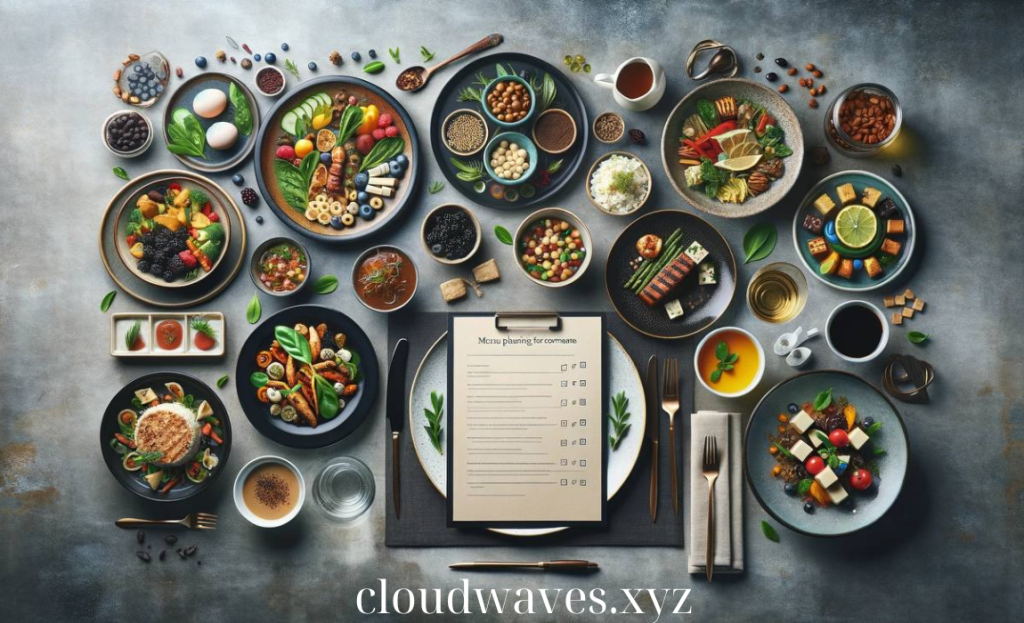Creating Menus and Events
High-End Menu Planning for Special Events: Curating a Culinary Experience to Remember
When it comes to high-end menu planning for special events, every detail matters. From luxurious ingredients to impeccable presentation, crafting the perfect menu requires a deep understanding of the occasion, guest preferences, and the latest culinary trends. Whether it’s a gala, wedding, corporate event, or exclusive dinner party, the right menu can elevate the entire experience, leaving guests with unforgettable memories. In this guide, we explore essential elements to consider when planning a high-end menu for your special event.
1. Understanding the Event Theme and Audience
Before diving into menu creation, it’s important to fully understand the event’s theme, guest expectations, and dietary requirements. Whether the event is a sophisticated black-tie affair or an intimate celebration, the menu should reflect the tone and style of the occasion.
- Customizing the menu to fit the event: For a formal event, consider multi-course dinners featuring haute cuisine, while more casual yet high-end events might call for gourmet small plates or tapas-style servings.
- Guest preferences and dietary needs: Ensure that your menu accommodates a variety of dietary preferences, including vegan, gluten-free, and allergy-friendly options. Offering diverse, luxurious choices ensures all guests feel included and catered to.
- Seasonality and local ingredients: Incorporating seasonal ingredients and locally sourced produce not only enhances the freshness and flavor of the dishes but also adds an element of sustainability to the menu, which is often a priority for high-end clientele.
Tip: Collaborate closely with your caterer or chef to ensure that the menu aligns with the event’s overall theme and guest expectations.
2. Elevating the Culinary Experience with Luxurious Ingredients
One of the key aspects of high-end menu planning is the use of premium ingredients that convey a sense of luxury and indulgence. These ingredients can transform a simple dish into a gourmet experience, impressing even the most discerning palates.
- Luxury ingredients to consider:
- Truffles: Known for their earthy and rich flavor, truffles are a classic ingredient in high-end cuisine. Incorporate them into dishes like truffle risotto or truffle-infused oils for an elevated touch.
- Wagyu beef: This highly marbled beef is prized for its tenderness and rich flavor, making it an ideal centerpiece for a main course.
- Caviar: A symbol of luxury, caviar can be served on its own or used as a garnish for seafood dishes.
- Foie gras: A delicacy made from duck liver, foie gras adds a decadent element to any appetizer or entrée.
- Fine seafood: Consider offering a seafood bar with oysters, lobster, and king crab legs. Pair these with upscale sauces and garnishes like champagne mignonette or lemon-basil aioli for added sophistication.
Tip: Use luxury ingredients sparingly to highlight their uniqueness and maintain a balance in flavors throughout the menu.
3. Creating a Multi-Course Gourmet Experience
For special events, a multi-course dining experience allows for a progression of flavors and textures that build excitement with each course. A well-curated menu should guide guests through a culinary journey, from appetizers to dessert.
- Suggested multi-course structure:
- Amuse-bouche: A single bite-sized hors d’oeuvre to start the meal, designed to excite the palate. Think truffle-infused cheese puffs or a small lobster bisque shooter.
- Appetizer: Light starters such as a smoked salmon carpaccio with crème fraîche or a rich, velvety foie gras pâté.
- Soup or salad: Seasonal soups like butternut squash with a hint of saffron, or a gourmet salad with burrata, heirloom tomatoes, and aged balsamic vinegar.
- Main course: Focus on proteins like filet mignon, lamb chops, or Chilean sea bass, paired with luxury sides like truffle mashed potatoes or asparagus with hollandaise sauce.
- Dessert: Decadent desserts such as a dark chocolate soufflé, raspberry tart with gold leaf, or a trio of artisanal cheeses.
- Wine pairings: To enhance the dining experience, consider offering wine pairings with each course. Collaborate with a sommelier to select fine wines that complement the flavors of the dishes, ensuring a harmonious dining experience.
Tip: Ensure the portion sizes are appropriate for a multi-course meal to prevent guests from feeling too full before dessert.
4. Perfecting the Presentation and Ambiance
Presentation is crucial in high-end menu planning, as it plays a significant role in the overall dining experience. The visual appeal of each dish should reflect the luxury of the ingredients and the sophistication of the event.
- Plate presentation: Focus on clean, elegant plating techniques that highlight the natural beauty of the ingredients. Use contrasting colors, textures, and garnishes to create visually stunning dishes that leave a lasting impression.
- Table setting and ambiance: The table setting should complement the high-end nature of the event. Opt for fine china, crystal glassware, and silver cutlery to enhance the luxurious atmosphere. Consider adding personalized touches such as custom menus or place cards.
- Live cooking stations: For larger events, incorporating live cooking stations can add an interactive and engaging element. Guests can watch skilled chefs prepare gourmet dishes like sushi rolls, hand-cut steaks, or flambéed desserts.
Tip: Collaborate with a designer or event planner to ensure the overall presentation of the menu aligns with the event’s aesthetic.
5. Curating a Memorable Dessert and Beverage Experience
Desserts and beverages are the final impression of any event, and they should be just as memorable as the courses that precede them. Consider offering a selection of decadent desserts paired with artisanal cocktails, rare wines, or aged spirits.
- Dessert options:
- Signature cakes: A custom-designed cake can serve as both a visual centerpiece and a delicious dessert. Opt for elegant flavors like champagne cake with vanilla buttercream or dark chocolate ganache with raspberry filling.
- Plated desserts: Offer individual desserts like crème brûlée, tiramisu, or lemon meringue tartlets, beautifully plated with edible flowers or spun sugar for an artistic touch.
- Petit fours: These bite-sized desserts, such as macarons, éclairs, and truffles, are perfect for guests who want a light, sweet bite to end their meal.
- Beverage pairings: In addition to wine pairings during the meal, offer a selection of after-dinner drinks such as port, cognac, or whiskey. Craft cocktails can also be a fun and creative way to complement the dessert course, using ingredients like espresso, citrus, and fine liqueurs.
Tip: Provide guests with a dessert and beverage station where they can customize their final course, allowing for a personalized touch to end the evening.
Conclusion: Elevating Your Event with High-End Menu Planning
High-end menu planning for special events is about more than just serving food—it’s about creating an extraordinary dining experience that resonates with your guests long after the event has ended. By incorporating luxurious ingredients, crafting a multi-course dining experience, and paying attention to presentation and ambiance, you can ensure your event’s menu is truly unforgettable. Whether it’s an intimate dinner or a grand celebration, the right menu will make your event one to remember.

